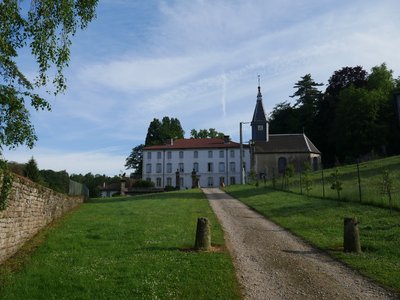Darney to Bains-les-Bains or La Vôge-les-Bains

Grand Est
11. Darney to Bains-les-Bains or La Vôge-les-Bains
Difficult
9h
35,1km
+732m
-692m
Step
Embed this item to access it offline
Your stopover ends in Bains-les-Bains, the centre town of the new commune of La Vôge-les-Bains since 1 January 2017.
You will discover the forest of Darney, the old Cistercian abbey of Droiteval, the valley of the Ourche. An unusual accommodation in the forest, an arborétum with a chapel inherited from the industrial families in this valley. The discovery of the rich heritage of Fontenoy-le-Château before arriving at the Royal Manufacture, witness of an important industrial past.
Finally this long stage ends in a spa town where St Colomban has been the patron saint of the parish since the 13th century.
You will discover the forest of Darney, the old Cistercian abbey of Droiteval, the valley of the Ourche. An unusual accommodation in the forest, an arborétum with a chapel inherited from the industrial families in this valley. The discovery of the rich heritage of Fontenoy-le-Château before arriving at the Royal Manufacture, witness of an important industrial past.
Finally this long stage ends in a spa town where St Colomban has been the patron saint of the parish since the 13th century.
8 points of interest

Château de Darney - Amis saint Colomban HistoricalDarney Castle
Darney has a rich history. The origin of Darney's name is believed by some to come from a Celtic name Daren Haye meaning Gateway to the Forest. Some think of a Gallic origin: the tumultuous torrent. The Saône river has its source 10 km upstream, it is the first city it meets during its slow progression towards the Rhône.
In the Middle Ages, the city was part of the Duchy of Lorraine and its fortified castle, enlarged, became an important military place. Darney was surrounded by an enclosure flanked by numerous towers, which earned it the nickname "Darney with 30 towers".
After passing successively into the hands of the Armagnacs and Charles the Bold, Duke of Burgundy, the castle was razed to the ground in 1639 by order of the King of France.
The church of Sainte Madeleine, built in the 18th century, is one of the very few churches we know that proudly displays on its pediment the motto of the Republic: Liberty, Equality, Fraternity. It was blessed on April 26, 1789 by the Reverend Seigneur Barret.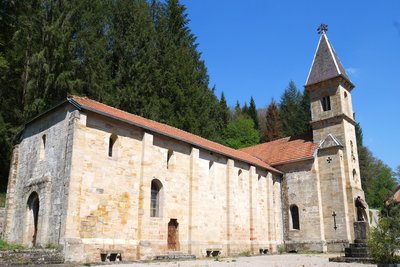
Église Prieurale Saint-Éloi, patron des forgerons - Amis saint Colomban TouristAncient Abbey of Notre-Dame in Droiteval
In a setting of greenery and water, the Cistercian Abbey of Droiteval was founded by Lord Aubert de Darney in 1160 and welcomed women until the 15th century. The abbey of Droiteval was the daughter of Morimond (Haute-Marne). From the 15th century the abbey became a priory at the beginning of the 18th century the prior installed a glass factory on the premises. The abbey was sold during the French Revolution. At the beginning of the 19th century, the premises are sold to a tinsmithing company specialising in forgeries, the forges of Droiteval. During the 20th century the premises were used as a small seminary and as a home for various organisations. Today, the church is privately owned, as well as the conventual buildings which house an Art and Culture Centre.
A very beautiful organ, from the Salle Poirel in Nancy, contributes to the magic of the place during concerts in summer.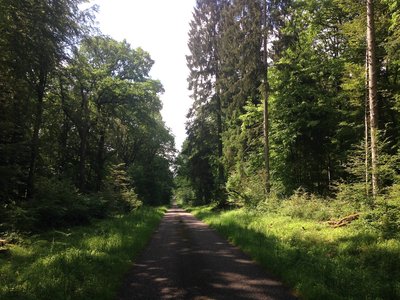
Forêt de Darney - Amis saint Colomban PanoramicDarney Forest
A natural site with a European reputation. The inhabitants of northern Europe come to recharge their batteries in this immense forest crossed by rivers and dotted with tourist sites. The 15,000 hectares of oak and beech trees are the green lung of 36 municipalities. It is also a renowned hunting reserve. The wood industry is very well established in the region, particularly the manufacture of staves and oak barrels.
Water, wood and sand are gathered in this forest to build glass factories. The Dukes of Lorraine brought Czech glassmaking families to the Darney forest, who, under the glassmakers' charter of 1448, became glassmaking gentlemen and developed this activity until the 17th century. There were nearly 30 glassworks, including a glassworks named after Saint-Valbert, the third abbot of the monastery of Luxeuil.
The glassworks of La Rochère, located west of the forest, is the oldest in France.
Plus d’informations Forêt de Darney : Wikipédia
Plus d’informations verreries de La Rochère : Wikipédia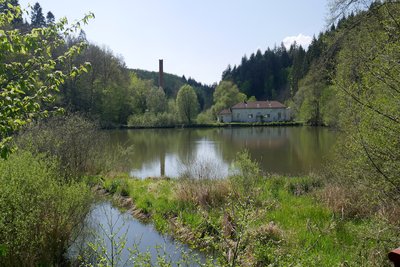
Ruines de la Forge Neuve devant son étang. - Amis saint Colomban HistoricalOurche Valley, forge of La Hutte
As early as the Middle Ages, the hydraulic power of the Ourche river allowed the installation of paper mills, glass factories, hence the name Glasshütte and forges. In 1749, the Duke of Lorraine Stanislas granted the Hut the privilege of being a "Royal Steel Factory". The workers from Lorraine, assisted by colleagues from Tyrol, transformed cast iron ingots from the neighbouring Franche-Comté into steel.
During your walk you will discover the remains of the layout of these old factories which alternate with their ponds, reservoirs of the driving force. The evolution of steel processing techniques evolved at the end of the 19th century leading to the abandonment of the forges in the Ourche valley.
The industrial ruins have been reclaimed by nature giving back a protected natural area all along your walk.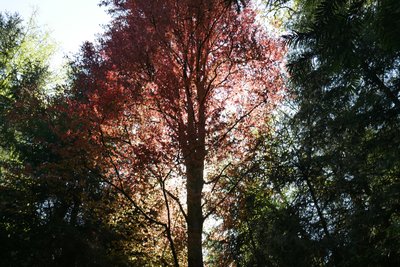
Arboretum de La Hutte, hêtre pourpre, réputé pour les sabotiers et les charrons - Amis saint Colomban PanoramicThe Chapel and arboretum of La Hutte
It was after the war of 1870 that the forge masters of the Hut decided to replace the old stone chapel of the factory. This large "mountain church" style building, inaugurated in 1876, had a double vocation: the practice of worship and a boarding school for the children of the forge, run by the Sisters of Portieux. It was closed in 1902, the chapel was desacralized and transformed into a dwelling.
The arboretum adjoining the chapel was planted by the smithy masters at the same time.
Let yourself be guided through the arboretum with multiple information panels on the varieties of tree species, including the immense sequoias.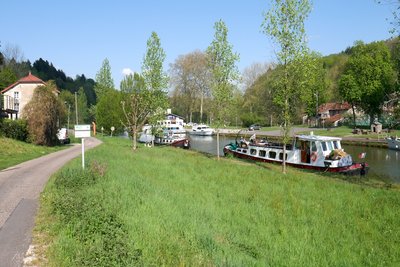
Port de plaisance de Fontenoy-le-Château - Amis saint Colomban TouristVosges Canal
The Canal de Vosges, which you will walk along for 8.5 km, is the southern part of the Canal de l'Est (built in the last third of the 19th century) which links the Meuse, Moselle and Saône rivers. As you cross the Vosges department it takes its name. Coming from Épinal, it crosses, with a few locks, the Monts Faucilles. Then it travels through the Coney valley for 50 km which is next to the canal to Corre in Haute-Saône.
An important transport route for local industry at the end of the 19th century, activity declined with the arrival of the faster train. Yachting, which links the North Sea to the Mediterranean, has regained possession of the canal, a not insignificant tourist contribution for the towns passed through. In summer, the activity of the port of Fontenoy-le-Château bears witness to this.
More information port of Fontenoy-le-Château
Port of Fontenoy-le-Château
The Canal des Vosges was built in the valley of the river Le Coney. The Coney is part of the Rhone basin but is so close to the Moselle valley that the Romans had already envisaged, under the reign of Nero, a connecting canal to link the North Sea to the Mediterranean, a canal which only came into being in the 19th century as part of the Freycinet programme.
In 1826, the geographical dictionary specifies that Flotation is carried out with lost logs and in rafts loaded with iron, glass, grindstones for cutlery...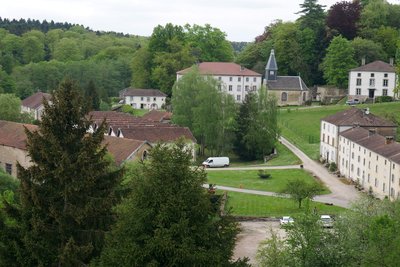
Vue générale de la Manufacture Royale - Amis saint Colomban HistoricalThe Royal Manufacture at Bains-les-Bains
Founded in 1733, this industrial site was to benefit from the driving force of the Coney. During the 20th century the forge masters built workers' towns with schools, churches and infirmaries. The Manufacture underwent this social evolution which improved the comfort of the workers but also settled them. Many were the day labourers who worked in the industry and changed industrial sites, exchanging their acquired knowledge for money as they travelled. In the 20th century the site was transformed into a tinsmith's factory specialising in the manufacture of nails.
Today the site is coming back to life with a museum, permanent exhibitions and guest rooms. Discover the 300 years of history of the site.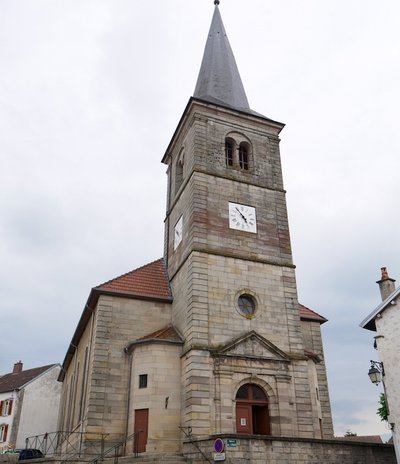
Église Saint-Colomban à La Vôge-les-Bains - Amis saint Colomban St ColumbanThe cult of Saint Colomban at Bains-les Bains
Saint-Colomban Parish
From the 13th century onwards, the town of Bains depended on the chapter of the canonesses of Remiremont, who appointed the parish priest. The monastery of Saint-Mont in Remiremont was founded, around 620, by the monk Amé from the monastery of Saint Colomban in Luxeuil and the noble Romaric.
By putting the church of Bains under the protection of Saint Colomban, the Canonesses wanted to recall the origins of their community and probably associate the thermal springs with those of Luxeuil restored by the first Irish monks.
One of the stained glass windows in the choir (on the right) recalls the name of Saint Colomban; the treasure of the church contains a monstrance containing a relic of the saint.
Saint Columban's thermal water
At the beginning of the 20th century, the public refreshment bar outside the Roman Bath was named Source Saint-Colomban (also known as "la Savonneuse"), which is the product of the mixing of the springs of this establishment; it is also operated in a small bottling station (opposite the Tourist Office) on the pediment of which the words "Source Saint-Colomban" can still be seen.
In the middle of the 20th century the marketing of Saint-Colomban water disappeared.
Description
Departure: Collegial Sainte-Madeleine de Darney
Go around the church, go to the back of the small car park, go down the stairs and turn left. At the intersection turn right into rue des Fabriques. Turn right up the hill. At the crossroads turn left and then straight on towards Attigny.
Go around the church, go to the back of the small car park, go down the stairs and turn left. At the intersection turn right into rue des Fabriques. Turn right up the hill. At the crossroads turn left and then straight on towards Attigny.
- After having passed the church of Attigny turn left (forbidden direction). Cross the Saône and turn right. After 80 metres take the first street on the left into the Route de Droiteval.
- You arrive at Notre-Dame de Droiteval. Leave the priory by crossing the river and turn left following the Ourche valley, route de la Forge Neuve.
- At the crossroads turn right and go along the pond of the new forge, stay on the tarred road and turn right on the metal bridge of the Ourche, go up along the arboretum and the old chapel, stay on the tarred road.
- At the intersection of the water tower turn left.
- At the exit of La Planchotte, turn right twice, straight ahead, following the ponds of the Morillon stream.
- At Peu d'Aquet turn left towards Ambiévillers. In Ambiévillers turn left, go through the village, first street on the right towards the church, go down the path to the canal.
- Cross the canal at the Gros Moulin lock and follow the canal until Fontenoy-le-Château. Cross Le Coney and turn left, Grande Rue. Take the second street on the right towards the church which you bypass to go down into the Grande Rue.
- First street on the left, rue de la Libération cross Le Coney after the bridge over the canal take on the right the towpath which borders the canal.
- Take the second lock, Grurupt lock n°32, to cross the canal and turn left towards the Manufacture de Bains. Cross the Manufacture and go up to your right, passing in front of the Chambre d'Hôtes towards the Châtelet, straight ahead in the direction of La Vôge-les-Bains rue du Chesnois.
- Turn right in the direction of the town centre, rue du Lieutenant-Colonel Chavane second street on the left, rue Marie Poirot after the crossroads you arrive at the Saint-Colomban church.
- Departure : Sainte-Madeleine Church, 30 rue de la République, 88 240 Darney
- Arrival : St-Columban Church, 4 rue d’Épinal, 88 240 La Vôge-les-Bains
- Towns crossed : Grand Est and Bourgogne-Franche-Comté
Altimetric profile
Transport
Report a problem or an error
If you have found an error on this page or if you have noticed any problems during your hike, please report them to us here:






